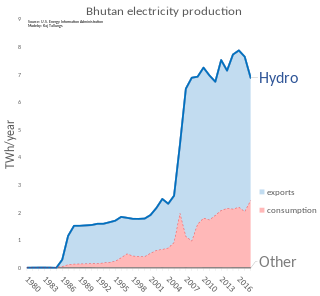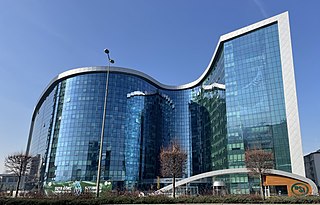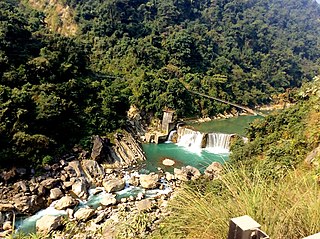
Hydroelectricity, or hydroelectric power, is electricity generated from hydropower. Hydropower supplies 15% of the world's electricity, almost 4,210 TWh in 2023, which is more than all other renewable sources combined and also more than nuclear power. Hydropower can provide large amounts of low-carbon electricity on demand, making it a key element for creating secure and clean electricity supply systems. A hydroelectric power station that has a dam and reservoir is a flexible source, since the amount of electricity produced can be increased or decreased in seconds or minutes in response to varying electricity demand. Once a hydroelectric complex is constructed, it produces no direct waste, and almost always emits considerably less greenhouse gas than fossil fuel-powered energy plants. However, when constructed in lowland rainforest areas, where part of the forest is inundated, substantial amounts of greenhouse gases may be emitted.

Sundarijal is a village and former Village Development Committee that is now part of Gokarneshwar Municipality in Kathmandu district in Province No. 3 of central Nepal.

Energy in Bhutan has been a primary focus of development in the kingdom under its Five-Year Plans. In cooperation with India, Bhutan has undertaken several hydroelectric projects whose output is traded between the countries. Though Bhutan's many hydroelectric plants provide energy far in excess of its needs in the summer, dry winters and increased fuel demand makes the kingdom a marginal net importer of energy from India.

Renewable energy in Nepal is a sector that is rapidly developing in Nepal. While Nepal mainly relies on burning biomass for its energy needs, solar and wind power is being seen as an important supplement to solve its energy crisis. The most common form of renewable energy in Nepal is hydroelectricity.

Hydroelectricity is a major source of electricity in Turkey, due to its mountainous landscape and many rivers. The country's main river basins are the Euphrates and Tigris. Over 700 hydropower plants have been built, and they make up about 30% of the country's electricity generating capacity. Annual generation varies greatly, and in rainy years lots of hydroelectric power can be generated. Government policies have generally supported building dams, but some are controversial in neighbouring countries, and some raise concerns about damage to the environment and wildlife.
Nepal Electricity Authority (NEA), founded on 16 August 1985, is the parent generator, transmittor and retail distributor of electric power under the supervision of the government of Nepal.
Chilime Hydropower Plant is hydro power plant in Nepal.

Hydroelectricity is currently China's largest renewable energy source and the second overall after coal. According to the International Hydropower Association, China is the worlds largest producer of hydroelectricity as of 2021. China's installed hydroelectric capacity in 2021 was 390.9 GW, including 36.4 GW of pumped storage hydroelectricity capacity, up from 233 GW in 2011. That year, hydropower generated 1,300 TWh of power, an increase of 68 TWh over 2018 when hydropower generated 1,232 TWh of power, accounting for roughly 18% of China's total electricity generation.

The Upper Tamakoshi Hydroelectric Project is a 456 MW peaking run-of-the-river hydroelectric project in Nepal. It is the largest hydroelectric project in Nepal, operating since July 2021. It is sited on the Tamakoshi River, a tributary of the Sapt Koshi river, near the Nepal–Tibet border.

Nepal is a country enclosed by land, situated between China and India. It has a total area of 148,006.67 square kilometers and a population of 29.16 million. It has a small economy, with a GDP of $42 billion in 2024, amounting to about 1% of South Asia and 0.04% of the World's GDP.
The Independent Power Producers Association Nepal is an association of private developers and owners of power producers of Nepal. It is a non-profit, non-government autonomous organization and was established in 2001. Its main objective is to link the private sector and government organizations involved in hydropower generation. IPPAN is primarily a membership organization. The General Assembly comprises both institutional and individual members. The General Assembly elects the Board of Directors, which then formulates the plans and policies of the organization. As of 2020, there are 580 private hydropower projects that are in operation or under construction with a total capacity to generate 21,000 MW. The private sector has invested about NPR 600 billion in these projects.
Upper marsyangdi A Hydroelectric Station is a run-of-river hydro-electric plant located in Bhulbhule of Lamjung district of western Nepal. The flow from Marshyangdi River is used to generate 50 MW electricity. The energy is evacuated by a 25 km long, 132 kv single circuit transmission line from Bhulbhule (powerhouse) to Middle Marsyangdi Hydropower Project.

Tinau Hydropower Plant is a run-of-river hydro-electric plant located in Rupandehi District of Nepal. The flow from Tinau River is used to generate 1.024 MW electricity.
Upper Mai-C Hydropower Station is a 6.1 MW run-of-the-river hydro-electric plant located in Ilam District of Nepal. It is powered by water from the Mai Khola.
Chake Khola Hydropower Station is a run-of-river hydro-electric plant located in Ramechhap District of Nepal. The flow from Chake River is used to generate 2.83 MW electricity.
Theule Khola Hydropower Station is a run-of-river hydro-electric plant located in Baglung District of Nepal. The flow from Theule River is used to generate 1.5 MW electricity.








